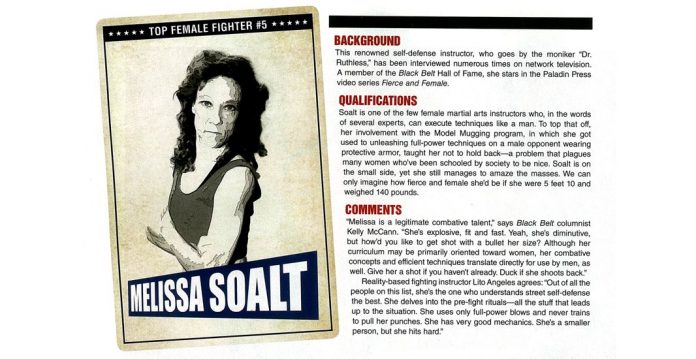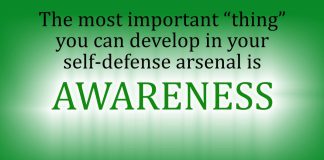These hips are big hips.
They need space to move around in …
These hips are free hips,
They don’t like to be held back …
These hips are mighty hips.
These hips are magic hips.
I have known them to put a spell on a man and spin Him like a top.
~ Lucille Clifton
These lines from Lucille Clifton’s delightful poem Homage to My Hips have always put a smile on my face. No, you haven’t turned to the wrong column. I’m still Dr. Ruthless, but I too have important reasons why you should love—not loathe—your hips.
More than womanly curves, or shelter for the unborn, a woman’s hips are her hub of power. And they make a dandy weapon. For example, if bear hugged from behind, a woman can thrust her rear into her attacker’s groin. (By thrust, I mean with a flat back and a vengeance, as if spearing him with your tailbone.) If effective, this hip-smacking strike could buy you an escape, or at least create an opening that allows you to follow up with additional moves.
In Praise of Our Lower Selves
It’s a fact: A woman’s lower half—her hips and legs— is the strongest, most powerful part of her body. Because women are typically smaller than men, we need to capitalize on our strengths to be effective in self-defense. Rule No. 1: Regardless of technique— whether you’re firing off a knee, elbow, palm strike or kick—get your hips into the act to deliver power. (Or as I prefer to say: “Hit with the big parts!”) The difference in power is literally stunning. When movement originates in the hips—via a snappy rotation or dip, or a driving or thrusting motion—the body becomes unified and works as a whole. It transfers power from your center-of-mass directly into your target. By striking with your body, and not just your body part (e.g., your hand or foot), you can deliver power that, according to my padded co-trainer, “feels like a low-velocity car wreck.” So too, the secret to hard-hitting throws, and thus sending a man head over heels, resides in our hips.
To get a feeling for your powers, try this experiment: When practicing knee strikes, instead of contracting your stomach muscles, freely sling your hips into your strike and allow your lower body to follow through like a wrecking ball. The result? WHAM! This motion allows you to get in deep and drive through your target. (“Good to the last drop,” I tell my students.)
Even in tight quarters, such as upright pins where movement is restricted, think of your hips as the motor in a Cuisinart blender. Once it’s switched on, your arms and legs can wield like slice-n-dice attachments. Adrenaline will provide the energy, but without those hips there’s no whip, chop or frappé!
Get Down, Girl!
To effectively liberate this power, you need to shift your center of gravity downward. This is no small feat! Lowering your center of gravity goes against the grain of Western culture and female conditioning, which exalts a high center of gravity (epitomized by the soldier’s “chest up, belly in” ideal and ballet’s heliumlike rise). Let’s face it: Popular culture rewards women for being lightweights, not heavyweights. We’re expected to acquire an unrealistic anti-gravity body, and to uphold our higher selves. Tragically, all this upholding and pinching off at the waist can cut women off from their base of power—from their lower, more formidable selves.
Once you get past this conditioning and learn to “get down,” oh what a relief it is! Lowering your center of gravity feels like a homecoming! It plunks you into an epicenter of power curiously located near the site of the womb—the hara, as it’s called in Japanese.
Although translated as “belly,” hara denotes a physical and spiritual seat of power; it is the source of, and connection to, primordial life force. In other words, it houses our ultimate potential—and all this power lives in your hips!
A Bundle of Benefits
Beyond explosive striking power, hunkering down in your hips and legs offers many practical self-defense benefits: It provides balance and stability, making you less of a pushover and allows you to pivot or push off and run in any direction. Possessing a sturdy pyramidlike stance also helps you remain grounded in the face of fear, counteracting the wave of panic that can make you rise up and out of your center (an action which can make you an easier target). By relaxing the belly and lowering your center, you also breathe deeper. This allows you to access a more powerful tone of voice, which is critical for setting boundaries with would-be assailants and personal-space invaders.
These low-down capacities also hold true in sexual assault positions, where coiling up into your belly can provide a momentary respite—a place to quietly gather your forces like the calm before the storm. Because hara is the seat of willpower, tapping this vital center can help you bring your innermost strengths to bear.
Hip Hip Hooray!
Thankfully, our relationships with our bodies and ourselves have changed radically over the decades. We are stronger and far more self-reliant and self-possessed than the June Cleavers of yesteryear. But old habits and self-perceptions, particularly in relation to our bodies, die hard.
To counter any negatives that you may secretly harbor about your hip region—such as “too wide,” “too scrawny,” “too this” or “too that”—and validate the splendors of that Grand Hub below, let’s turn our attention to Japanese culture where Sumo reigns supreme and exemplifies the power of all things, well, hip. For example, Black Belt magazine columnist Dave Lowry reminds us that a koshinuke in Japanese is a person “without hips”—which denotes a coward! The term koshi ga takai, meaning “things with high hips,” is considered an insult. It means, says Lowry, “that you are executing a technique, or maybe just sitting or standing with your body unbalanced and top-heavy.” (Now there’s a striking contrast to a culture that shuns women who are bottom heavy. Can we imagine Sumo Barbie?) The phrase hara ga tatsu, meaning “a person whose belly rises,” is also an insult. It refers to one who rises out of his or her seat of power, as opposed to residing snugly in the hips.
How refreshing!
In a world where women’s bodies are the targets of both scrutiny and attack, inhabiting our lower selves may not only be lifesaving—and liberating—but it connects us to capacities far beyond the physical. Leave it to the ancients to convey this simple lesson: A woman who lives in her hips is a woman of power.
COPYRIGHT © NOTICE: This article is protected by Copyright law. NO copy, reproduction or reprinting without written authorization. All rights reserved.






